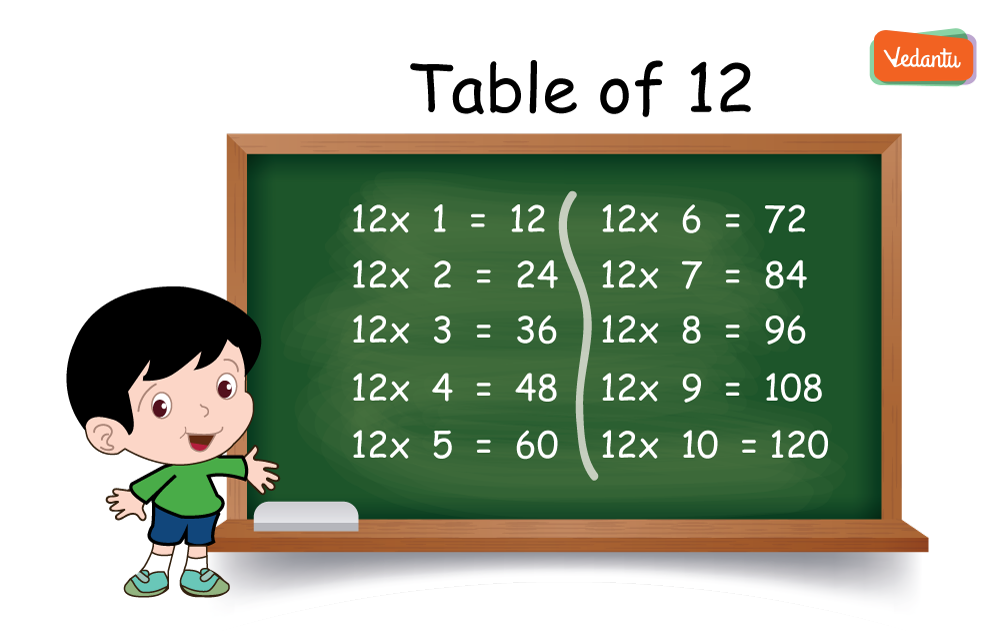Table of 12: Multiplication Made Simple
FAQs on Table of 12: Multiplication Made Simple
1. What is the 12 times table and how is it formed?
The 12 times table is a list of multiples of the number 12. It is fundamentally created by using repeated addition. You start with 12 (which is 12 x 1), then add 12 again to find the next multiple: 12 + 12 = 24 (which is 12 x 2). You continue adding 12 to the previous answer to generate all subsequent products in the table.
2. What is a simple trick to remember the 12 times table?
An easy and effective trick is to use the 10 times table and the 2 times table, both of which are usually easier to remember. To find any multiple of 12, first find the multiple for 10 and 2 separately, and then add them together. For example, for 12 x 4, you would calculate 10 x 4 = 40 and 2 x 4 = 8. Adding these results gives you the answer: 40 + 8 = 48.
3. Why is learning the 12 times table important for daily life?
Learning the 12 times table is very useful because the number 12 is a common unit of measurement in many real-world situations. Some practical examples include:
- There are 12 months in a year.
- A dozen items, such as eggs or doughnuts, equals 12.
- A standard ruler often measures 12 inches (which is one foot).
- A clock face is divided into 12 hours.
4. Is there a pattern in the last digits of the 12 times table?
Yes, there is a distinct and helpful pattern in the last digit (the units place) of the multiples in the 12 times table. The last digits repeat in a cycle of five numbers: 2, 4, 6, 8, 0. For example, 12 x 1 = 12, 12 x 2 = 24, 12 x 3 = 36, 12 x 4 = 48, and 12 x 5 = 60. This pattern then starts over for the next five multiples, making it easier to predict and check your answers.
5. How is the 12 times table related to the tables of 2, 3, 4, and 6?
The 12 times table is directly connected to these smaller multiplication tables because 12 has several factors. Since 12 can be formed by multiplying both 2 × 6 and 3 × 4, every number in the 12 times table is also a multiple of 2, 3, 4, and 6. This is a great way to check your work; for instance, we know 12 x 7 = 84, and we can verify that 84 is also divisible by 2, 3, 4, and 6.
6. What does '12 times 5' actually mean?
The expression '12 times 5' is a way of describing the core concept of multiplication as repeated addition. It signifies that you are taking the number 12 and adding it to itself a total of five times (12 + 12 + 12 + 12 + 12). The result, 60, represents the total value of 5 groups of 12.
7. What is a common mistake students make when reciting the 12 times table?
A frequent mistake is miscalculating the addition when deriving the table mentally, especially for larger numbers. For example, when calculating 12 x 7, a student might correctly recall that 12 x 6 = 72 but then incorrectly add 12, resulting in an answer like 82 or 83 instead of the correct 84. Focusing on accurate addition of the tens and units digits is key to avoiding this error.
8. How can you quickly find what 12 x 9 is using the table?
To quickly find 12 x 9, you can use a subtraction trick. It's often easier to calculate 12 x 10, which is 120. Since 9 is one less than 10, you can simply subtract one group of 12 from 120. So, the calculation is 120 - 12 = 108. This method is often faster than repeated addition or direct memorisation for some students.
















